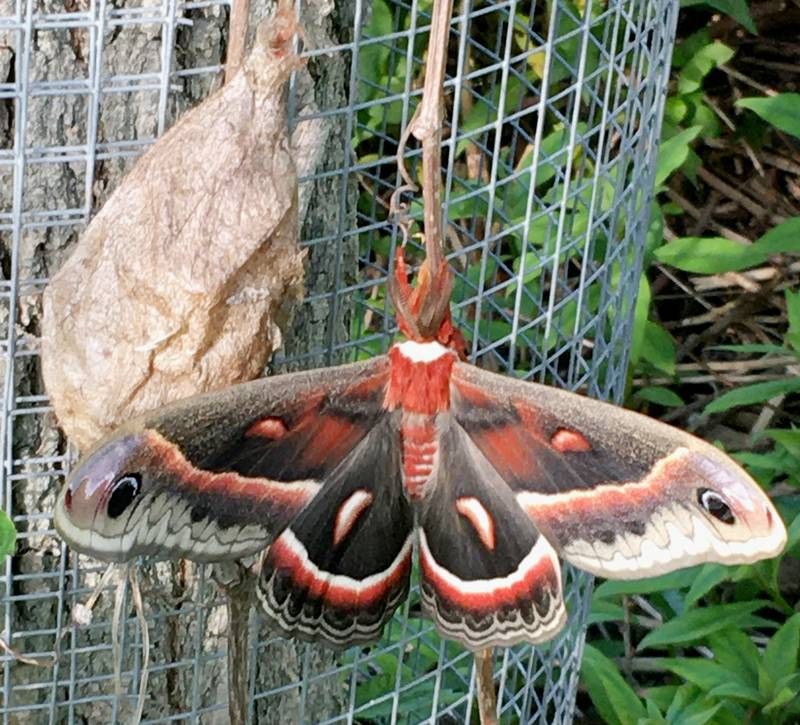Wilma Kenny | Jun 01, 2022
The Cecropia is the largest and perhaps rarest of the native North American silk moths. Only two weeks of its one-year lifespan are spent in this spectacular, fragile state. Its whole purpose in that time is to mate and lay eggs.
It does not eat; it has no functional mouthparts or digestive system.
Early this spring, I found two large moth cocoons in the garden: one had been emptied, possibly by a squirrel, but the other was intact. It was a few feet off the ground on a metal beaver-barrier collar around the trunk of an umbrella elm. I checked it occasionally and was lucky a few days ago to discover the moth freshly emerged. Its plump body was at least 5 cm long, finger-sized, furry, and intricately patterned in black, white and red. The wings gradually unfolded and pumped up to full size: a 15 cm wingspan. Overall size and short antennae indicated a female. By dusk, it had flown off to seek a mate.
Although the female will lay up to 100 eggs, very few survive to become adult moths. Cecropia has two major enemies: outdoor lights, and a small parasitic wasp. Moths, which are nocturnal, appear to be distracted by porch and street lights: one theory suggests these lights interfere with the moth’s natural ability to navigate by the moon.
Even more dangerous is the parasitic wasp C. Concinnata. It was introduced in 1906 to try to control the spread of the Spongy Moth (the recently renamed gypsy moth), which had itself been introduced in the late 1800’s in an unsuccessful attempt to begin a silk industry in the United States. The tiny fly-like wasp injects its eggs into the moth larva, or worm, where they hatch and gradually kill the host by eating it. While it has never had more than a small effect on the Spongy moth population, it has noticeably diminished the population of Cecropia moths.
“Research on giant silk moths suggests that C. concinnata has become the major source of mortality among several species and may be responsible for the notable decline in their densities that has occurred over the last century. C. concinnata has been touted as a premier example of the generalist natural enemy that should be avoided in classical biological control introductions…” Elkinton & Boettner, U of Mass. 2012.
he Cecropia larva/worm eats leaves, preferring sugar maple or Manitoba maple, but will settle for birch, poplar, cherry and other hardwoods. However, these moths are so uncommon that they have never become a threat to the trees. (Of the original hundred eggs laid in any one area, very few survive to hatch.) A larva sheds its skin four times over the summer as it grows, each time also shedding any eggs laid by native predators on the outer skin. Beginning with a tiny black caterpillar (similar in appearance to the small Spongy moth caterpillar), it becomes larger and more brightly-coloured with each new skin: in the last three stages, it is green with lines of bright red, blue and yellow bumps, each topped with a cluster of black spikes.
At no time is it poisonous, but its appearance probably is enough to scare off predators. By the end of July a person may come across one of these very strange ‘space alien’ caterpillars wandering off to find a good place to spin its cocoon. The cocoon has both inner and outer walls, with a fluffy insulating layer between. It protects the inner pupa (where the moth forms) from the winter cold.
And in late May, early June, the cycle begins (or ends) again.
More Stories
- Latest CUPW Job Action Stops Postal Delivery Of The Frontenac News Forcing Alternate Plans
- Opponents of Barbers Lake Gravel Pit Pack Ag Hall in McDonalds Corners
- Bobsleigh Olympian Jay Dearborn At Mikes Pizza In Sydenham
- The Loins Club Of and O'Lakes Roar
- North Frontenac Back Roads Studio Tour - September 27 and 28
- Sunday Market Vendors Give Back
- George Street Work As Town Hall Renovation Nears Completion
- One Way Street Plan Hits A Dead End - Central Frontenac Council, September 9
- Global Gardening
- No Winner Yet in Catch The Ace But Fundraising Target Met

